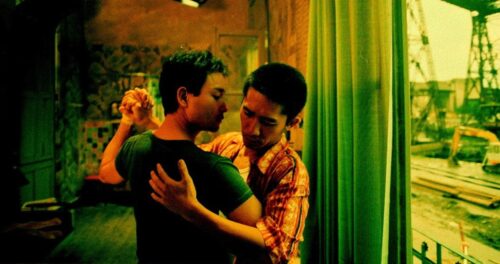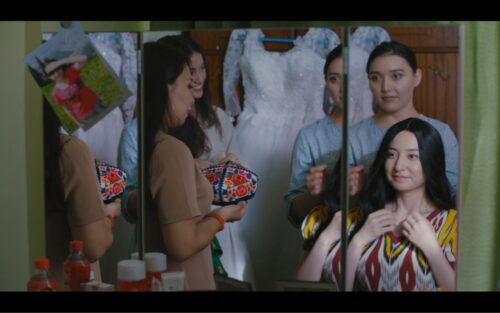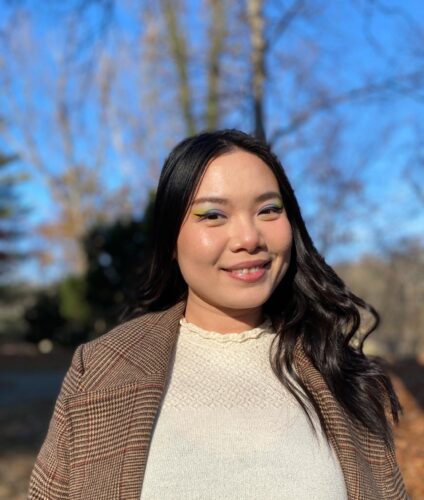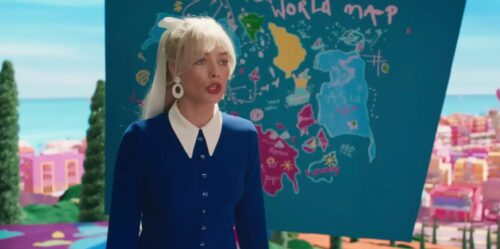Bringing a dumpling to life: Q&A with Domee Shi, Pixar director of ‘Bao’

Domee Shi is the first female director of a short film by Pixar Animation Studios. Her piece, the recently released Bao, is a whimsical story loosely based on her own life growing up as an only child with Chinese immigrant parents in Canada. Bao is screening this summer before Incredibles 2.
The film premiered earlier at the Tribeca Film Festival, with a synopsis that reads: “An empty-nesting Chinese mom gets another chance at motherhood when one of her dumplings springs to life. But she must come to terms with the bittersweet revelation that nothing stays cute and small forever.”
Shi, 28, started as a story intern with Pixar in 2011, and was soon hired to work on feature films, including Inside Out, The Good Dinosaur, Incredibles 2, and Toy Story 3.
She was born in Chongqing, grew up mostly in Toronto, and is now working on a 90-minute feature film for Pixar. She chatted with The China Project about Bao, women in animation, and, of course, her favorite dumplings.
Sophia Yan, The China Project: Talk to me about the origin of Bao — how the idea came about, where you drew inspiration from.
Shi: I got the idea for Bao over four years ago. I was working at Pixar as a storywriter, working on the film Inside Out, but was itching to do something creatively on my own. I was brainstorming one night, and the image popped in my head of an old Chinese lady nuzzling this little dumpling boy to death, and I had to draw it out on paper immediately. From that one drawing, the idea started forming.
I started thinking about my own life growing up — as an only child, I have always felt like a very overprotected, nuzzled little dumpling by my Chinese mom. And I really wanted to tell a story that explored the relationship with an overprotective parent learning to let go of her kid, using this dumpling, this bao as a metaphor.
I’m a huge foodie as well, and it was definitely a conscious decision to create a story around food.
Yeah.
Shi: I love eating food, and I love drawing food. I think it’s really relaxing, it’s interesting to me to research the process of making, cooking, and eating food.
And I think especially in Chinese culture, food and family go hand in hand, and the whole dumpling-making process is a very family-oriented activity. I thought, what better way to tell a story about family than using a dumpling as the vessel.
l was also drawing inspiration from classic fairy tales like the “Little Gingerbread Man” to explore the light and dark themes that you find in them and introduce that into Bao.
Did you seek input from your family, your mom, while you were developing the film?
Shi: Yeah, I definitely involved my mom a lot. The whole opening of Bao, the dumpling-making process — we heavily researched that by inviting my mom to Pixar to do dumpling-making classes for the crew. Twice!
It was really important for me to get the animators, effects artists, in there watching my mom and observing her every movement. We set up the camera so that we were almost replicating the shots that were in the short in real life, and when it came time to animate those shots, we told the animators to use my mom as reference. Make sure you get every detail down exactly. It was important for me to get every single step of my mom’s dumpling-making process on the big screen.
Also, I talked with her a lot about what it was like raising me, because I’m not a mom myself. This short is told from this overprotective mom’s point of view, so I had to do a lot of research and talk to her, talk to other parents on the crew to ask them about their experience from that side of the relationship, because I’d always been on the smothered, overprotected little kid side. I wanted to know more about why parents feel that way, feel that urge to keep their kids so, so close.
How have your parents reacted to seeing the final short?
Shi: My mom’s really proud. I invited her to the premiere in Los Angeles, and I took her around to do all the interviews with [me], and she’s really proud. She’s not a super outwardly emotional person, but I definitely saw her eyes get misty when she was watching it, and when people are coming up and congratulating me. I’m like the symbol of her Western dream. She and my dad came so far away from China to Canada, and we had so little growing up. I’m their success story.
What has your dad said?
Shi: My dad? He loves it too! He’s always been my biggest fan. Every time I’ve seen him, he is always rocking Pixar swag, like the t-shirts, the hats. He’ll never not wear anything Pixar-related now. He’s an artist himself, and I got into art and drawing because of watching him while growing up. As a kid, he would teach me a lot of stuff, like drawing and painting, and I owe a lot of my success to him.
He always calls me his “internationally famous artist director daughter.” I’m like, that’s too long of a title, Dad!
He’s extremely proud, but also, he’s still my dad and that side of him comes out, too. Like, I asked him what he thought [of the film] and he said, “I really liked it, but I also have notes for you.” And I was like, Ah, that’s my classic dad.
That’s funny!
Shi: Oh yeah! He had suggestions, observations. He’s a teacher at heart. He’s an art professor and he was my art teacher for a while. He can’t help but get into that role when he talks to me.

There’s no dialogue in the entire film. What was the rationale behind that decision?
Shi: I wanted to make the story as universally understood as possible. By removing language as a barrier, everyone around the world can experience the short in the same way. I also wanted to challenge myself to tell the story as visually as possible. Animation is such a visual medium, and I wanted to take advantage of that and push the acting, the set design, the colors, and the lighting to really tell the story and evoke the emotions and characters without having to rely on words.
I come from a visual storytelling background. I’m a storyboard artist at heart, and I just really wanted to tell Bao in as little words as possible.
If you listen carefully, there is a TV show that is playing in the background, one of the shots in the dining room when the dad character is watching the TV, and the mom character is setting the table. That’s the only dialogue we recorded for the whole short, and we actually had to write a script.
It’s my homage to the Cantonese soap operas I would watch growing up with my mom. The story in the TV show is a parallel story — an adult son and a mom character arguing in Mandarin. That’s the only dialogue in the short, technically.
A lot of what is observed, presented, understood in the West about Chinese — and broader Asian — culture can often seem sort of stereotypical or trite. For instance: Chinese people with small eyes. Were you worried about that with this film, and how did you work to overcome it?
Shi: I wasn’t that worried about it, because I was given so much creative control over the look and the feel of the short. Rona [Liu], the production designer — she is Chinese American, and since both of us come from a similar background, we have only the best intentions in depicting our own culture and communities.
I felt pretty good about the way we designed all the characters. My only rule is — make sure we’re drawing from life, from truth, our truth. When we were designing the characters we were looking not only at ourselves, we were looking at our moms, our aunts, our uncles.
Me and Rona, we went back to our parents’ houses and took tons of pictures, of the living room, the kitchen, all the little tchotchkes on our parents’ televisions, shelves.
We made sure when we were presenting this research and look to the crew, a lot of whom were non-Asian, we were explaining our thought process, so everyone understood why we made every single little decision.
I got a kick out of small things, like the house décor you mentioned. I’m Chinese American, and it reminded me of my own mom’s house when I was growing up, which — by the way — hasn’t changed much. And even the clothing, the details on the outfits that everybody wore.
Shi: Awesome. We took tons of pictures; I raided my mom’s closet! We also went on several trips to Oakland and San Francisco Chinatowns — the crew — and we observed a lot of the color choices and patterns. Everyone has their own style, but you start seeing patterns especially in the older Chinese men and women — floral prints, comfortable walking shoes, the visors.
Mismatched prints, clashing colors…
Shi: Yeah! It’s kind of awesome.
I’m looking forward to the day I can pull that off.
Shi: I now own a visor and I’ve worn it once as I went for a walk around my neighborhood. I was like, “Yes, I’m just owning this!”
You’re the first female to direct a short for Pixar. For all the budding animation artists — and women — out there, tell me about how you got here and what that road was like.
Shi: I’m super honored and humbled to be the first. It didn’t quite hit me until after we finished the short and it was coming out. That’s when it felt real. Also, I feel like, “Man, it’s about time!” I definitely hope we’re at the beginning of a long trend of kick-ass female directors in animation and live action.
I see the change happening in the schools and I’m excited to see it happening in the industry, because enrollment in animation programs all across North America, it’s now over 50 percent girls who are getting into animation, whereas 10, 20, 30 years ago it was probably over 50 percent boys. You’re seeing a natural shift. I’m excited to see that reflected in the industry. It’s happening and there’s nothing you can do to stop it!
I didn’t realize the change was happening already in the schools.
Shi: Yeah, when I was in animation school I think it was 50-50 already. I graduated around seven years ago. You’re going to start seeing more and more women in leadership roles in this industry.
I definitely think it’s also because of the internet. When I was growing up and getting into art and animation, I went on these online art communities and art blogs. The internet suddenly gave me access to all of these resources I wouldn’t have before.
I also come from a Chinese immigrant family, and a lot of times the stereotype is that there are four or five career options: doctor, engineer, lawyer, accountant. How did that play out for you when you were pursuing your career?
Shi: When we immigrated to Canada, it was hard for my father to get a job, a teaching job, or to sell art, a lot because of the language and cultural barriers. He struggled a lot as an artist, so he didn’t want me to struggle as much as he did.
But I convinced them! First, I was like, “Animation is different, Dad! It’s a multi-billion dollar industry! People have day jobs. It’s something where you can work at a company…and there are lots of cool opportunities, and cool studios in Canada and America for it.”
My parents have always been supportive of me. The only rule was, if you’re going to pick something — a career, a path — you better stick to it and not quit. Put your all in it.
You’re clearly a dumpling lover. It must be hard to fight hunger working on a dumpling film. Do you have a favorite type of dumpling?
Shi: I really grew to like Shanghai soup dumplings, which I didn’t eat that much of until I got to the Bay Area. But my top favorite dumplings are obviously the ones I grew up eating — the boiled pork and chives dumplings that my mom would make for me growing up.
How involved were you in developing the film’s music, scored by Toby Chu?
Shi: It was a really fun collaboration…I told him that I wanted to incorporate Eastern and Western instruments into the score. I really wanted it to be a blend, just like how the story is a Chinese immigrant story that takes place in Toronto, Canada.
He had a cool idea of assigning different instruments for the characters. For the mom character, when you first open the short with her, and it’s just her making the dumplings, you hear more Chinese instruments, like the erhu. When the dumpling is growing up and getting more into Western stuff and friends, the orchestration changes — you start hearing French horn and violin.
The music is reflective of the mom character’s arc and how her world is changing. We end the short with a mixture of both — just like the family.
** SPOILER ALERT **
Ed’s note: This is the final question, and the answer contains spoilers of the ending.
** SPOILER ALERT **
What are you trying to say or show with the ending? I wasn’t quite sure what to make of it myself.
Shi: The whole act came from my mom always hugging me and holding me close and saying, “I wish I could put you back in my stomach so I knew where you were exactly at all times.” To me, the mom character doing that is her last ditch attempt to try to keep her baby with her forever.
Her kid is grown up, he’s going to leave the nest, and she’s so distraught about it that the only thing she can do in the moment is to put him somewhere he can never, ever leave her.
She immediately regrets it — she cries. Then, she wakes up. My intention with the ending was that the human son coming home is revealing that this magical dumpling story was a metaphor. It was all a fantasy, a way for this mom character to process her real son moving away and leaving the nest. And it took this dumpling fever dream for her to reconcile with her real son.
We kind of dropped hints that the dumpling is the human son in the design. And with his girlfriend, it’s the same girlfriend you see earlier in the short. We also put little hints throughout the whole house in the dining room — you see photographs of the mom character and the dad character with this little human boy, so its subtly hinted at in the short. It’s always fun for me to see the audience’s reactions to that scene when she eats him.
This interview has been edited for clarity and length.





